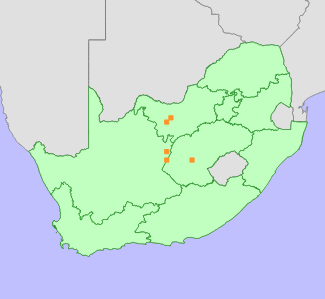|
Scientific Name | Brachystelma dimorphum R.A.Dyer subsp. dimorphum |
Higher Classification | Dicotyledons |
Family | APOCYNACEAE |
National Status |
Status and Criteria | Vulnerable B2ab(iii,v) |
Assessment Date | 2016/08/24 |
Assessor(s) | N. Hahn & L. von Staden |
Justification | A widespread (EOO 22 158 km²), but localized habitat specialist (AOO estimated to be <2000 km²). It is known from fewer than 10 locations, but might be overlooked. It is suspected to be declining due to ongoing loss and degradation of its habitat. |
Distribution |
Endemism | South African endemic |
Provincial distribution | Free State, Northern Cape, North West |
Range | Kimberley to Vryburg and Bloemfontein. |
Habitat and Ecology |
Major system | Terrestrial |
Major habitats | Kimberley Thornveld, Stella Bushveld, Winburg Grassy Shrubland |
Description | Alluvial soils and large, shallow pans in grassland. |
Threats |
| This taxon is threatened across its range by ongoing habitat loss and degradation, particularly agricultural expansion on alluvial soils, as well as spreading settlements, mining, alien invasive plants and degradation due to overgrazing. |
Population |
This taxon is known from only five collections, scattered over a wide area, and was last recorded in 1971. It is possibly localized to salt pans - three of the records are from areas surrounding salt pans - which may explain its rarity, areas of suitable habitat would be generally small in extent, and widely scattered. Its distribution range is however botanically very poorly sampled, and in addition, it is a cryptic species, which would make it easily overlooked (Hahn 2013). It is possibly more common, but field surveys are needed to relocate it in the wild, and to gain a better understanding of its habitat preferences, population size and status. Searches at known localities near Kimberley and in North West Province have thus far failed to relocate these subpopulations.
|
Population trend | Decreasing |
Assessment History |
Taxon assessed |
Status and Criteria |
Citation/Red List version | | Brachystelma dimorphum R.A.Dyer subsp. dimorphum | VU B2ab(iii,v) | 2017.1 | | Brachystelma dimorphum R.A.Dyer subsp. dimorphum | Least Concern | Raimondo et al. (2009) | | Brachystelma dimorphum R.A.Dyer subsp. dimorphum | Lower Risk - Least Concern | Victor (2002) | | Brachystelma dimorphum R.A.Dyer subsp. dimorphum | Indeterminate | Hilton-Taylor (1996) | |
Bibliography |
Dyer, R.A. 1979. ASCLEPIADACEAE: New records of Brachystelma. Bothalia 12(4):627-629.
Dyer, R.A. 1980. Brachystelma, Ceropegia and Riocreuxia. In: O.A. Leistner (ed). Flora of Southern Africa 27 Part 4:1-88. Botanical Research Institute, Pretoria.
Dyer, R.A. 1983. Ceropegia, Brachystelma and Riocreuxia in southern Africa. A.A. Balkema, Rotterdam, Netherlands.
Hahn, N. 2013. Rare, endangered and endemic flora of the North West Province. Unpublished Report to the Department of Economic Development, Conservation and Tourism, North West Provincial Government.
Hilton-Taylor, C. 1996. Red data list of southern African plants. Strelitzia 4. South African National Botanical Institute, Pretoria.
Raimondo, D., von Staden, L., Foden, W., Victor, J.E., Helme, N.A., Turner, R.C., Kamundi, D.A. and Manyama, P.A. 2009. Red List of South African Plants. Strelitzia 25. South African National Biodiversity Institute, Pretoria.
Victor, J.E. 2002. South Africa. In: J.S. Golding (ed), Southern African plant Red Data Lists. Southern African Botanical Diversity Network Report 14 (pp. 93-120), SABONET, Pretoria.
|
Citation |
| Hahn, N. & von Staden, L. 2016. Brachystelma dimorphum R.A.Dyer subsp. dimorphum. National Assessment: Red List of South African Plants version 2024.1. Accessed on 2025/11/30 |
 Comment on this assessment
Comment on this assessment


